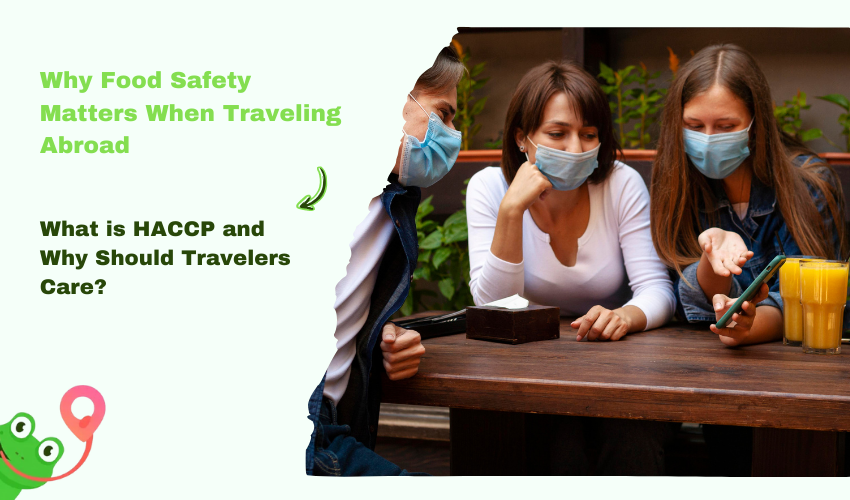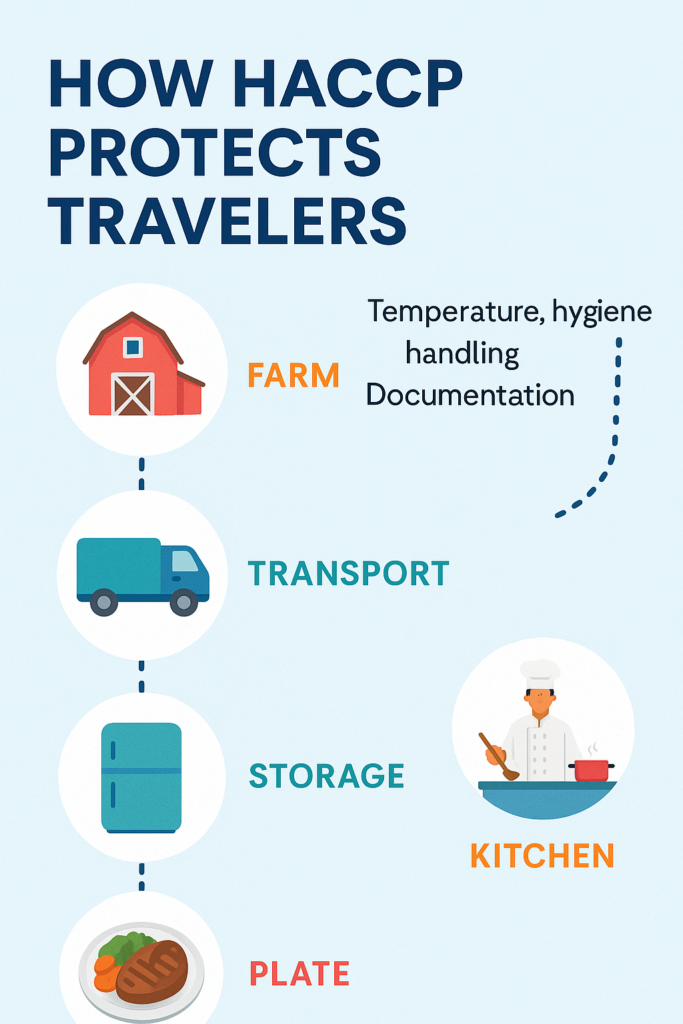Why Food Safety Matters When Traveling Abroad: How HACCP Standards Protect You

Travel is all about new experiences: wandering through bustling night markets, sampling authentic dishes in family-run restaurants, or dining at five-star hotel buffets. For most travelers, food is one of the highlights of any journey. Yet, it can also be one of the biggest risks. According to the World Health Organization, contaminated food causes illnesses in 600 million people annually, with severe consequences ranging from mild stomach upset to life-threatening infections.
For travelers, this risk is amplified. You’re constantly exposed to new cuisines, preparation methods, and hygiene standards that may differ from what you’re used to at home. Even something as simple as eating fresh fruit washed in tap water can turn a dream vacation into days of discomfort.
This is where Folio3 FoodTech HACCP Software comes in. Originally developed by NASA to ensure food safety for astronauts in space, HACCP has grown into a globally recognized system that forms the backbone of modern food safety regulations. It’s the invisible safety net working behind the scenes in hotels, airlines, restaurants, and food suppliers worldwide.
In this article, we’ll explore why food safety is so critical when traveling, how HACCP standards protect tourists every day, and what practical steps you can take to enjoy authentic food experiences abroad without worry.
Section 1: The Hidden Risk of Foodborne Illness in Travel
Travelers often underestimate the scale of foodborne illness risks. Studies show that 20–50% of international travelers will experience some form of food-related illness, with “traveler’s diarrhea” being the most common. While it’s often mild, in some cases it can result in hospitalization, missed flights, or even trip cancellations.
There are several factors that make travelers especially vulnerable:
- Different hygiene practices: What’s considered normal in one country may not meet safety expectations in another. Street vendors may not have access to clean water or refrigeration.
- Ingredient sourcing: Raw foods like seafood or leafy greens may be contaminated by local water supplies or unsafe handling.
- High turnover environments: Busy tourist spots serve thousands of meals daily, increasing the chance of errors.
- Climate: Hot and humid regions accelerate bacterial growth in food if storage conditions aren’t strictly maintained.
Common illnesses include Salmonella, norovirus, E. coli, and hepatitis A. Beyond the health risk, foodborne illness can derail an entire itinerary. Imagine flying halfway around the world only to spend days confined to a hotel room instead of exploring temples, beaches, or museums.
What many travelers don’t realize is that these risks are preventable. Food businesses that adopt strict HACCP compliance significantly reduce the chances of contamination at every stage — from supplier to plate. The difference between a safe dining experience and a ruined holiday often comes down to how seriously food safety is taken by local establishments.
Section 2: What is HACCP and Why Should Travelers Care?
HACCP stands for Hazard Analysis and Critical Control Points, and while it may sound technical, its purpose is simple: to prevent food safety hazards before they cause harm. The system identifies potential biological, chemical, and physical hazards in food production and establishes controls to eliminate or minimize them.
For travelers, HACCP may not be something you can see on a restaurant menu, but it’s the reason your sushi in Tokyo is free from parasites, your seafood pasta in Rome isn’t spoiled, and your in-flight meal is safe to consume at 35,000 feet.
A few key reasons why HACCP matters for travelers:
- Global recognition: HACCP is not limited to one country. The EU, the US, Canada, and many parts of Asia mandate HACCP for food businesses, meaning it protects travelers across multiple destinations.
- Prevention-focused: Unlike old systems that responded after contamination occurred, HACCP prevents issues before they happen.
- Tourism reliance: Countries that depend heavily on tourism have extra incentive to adopt HACCP, because sick tourists hurt reputations and revenues.
Take Thailand as an example: famous for street food, yet Bangkok authorities run strict vendor hygiene programs aligned with HACCP principles. Similarly, luxury hotel chains in Dubai or Singapore invest heavily in HACCP compliance to reassure international guests.
For travelers, the bottom line is clear: the presence of HACCP in global food systems directly impacts your ability to eat with confidence abroad.
Section 3: How HACCP Works Behind the Scenes (Traveler’s POV)
Every safe meal you enjoy while traveling is the result of dozens of unseen checks guided by HACCP. Here’s how the system works in real-world scenarios:
- Ingredient Sourcing: A hotel buffet in Paris sources its seafood only from certified suppliers. HACCP requires documentation of freshness, proper transport, and supplier audits. This means the oysters you enjoy are less likely to harbor dangerous bacteria.
- Storage & Transport: Airline caterers rely on cold-chain monitoring to ensure food stays below safe temperatures from kitchen to aircraft. Any breach in temperature is logged and addressed immediately.
- Preparation & Cooking: A tapas bar in Madrid may use HACCP checklists to ensure meats are cooked to the correct internal temperature to kill pathogens.
- Handling & Hygiene: HACCP mandates that staff follow strict hygiene protocols — from handwashing to equipment sterilization — reducing cross-contamination.
- Traceability: If a food issue arises, HACCP requires full documentation of every stage. This traceability allows quick recalls, protecting not only locals but also travelers.
Travelers may never see these processes, but they make a world of difference. Without HACCP, hotels, cruise lines, and airlines would be at higher risk of outbreaks that could harm their reputation and customer trust.

Section 4: Countries and Tourism Sectors That Enforce HACCP
Different regions adopt HACCP with varying levels of enforcement, but the trend is global:
- European Union: All food businesses are legally required to implement HACCP principles. This means from French patisseries to German breweries, tourists are eating food prepared under strict systems.
- United States & Canada: HACCP is mandatory for seafood, meat, and juice industries, but hospitality often goes beyond requirements to reassure international guests.
- Asia: Countries like Singapore, Japan, and Malaysia have robust HACCP programs, especially in urban centers and hotels catering to global tourists.
- Middle East: Dubai, a major tourism hub, enforces HACCP across hotels, restaurants, and catering, aligning with its brand as a luxury destination.
- Airlines & Cruise Lines: International carriers like Emirates, Singapore Airlines, and Delta use HACCP frameworks in catering operations, serving millions of meals daily with minimal incidents.
For travelers, this means your dining experience is protected not just by luck, but by deliberate, global systems designed to keep you safe.
Section 5: Tips for Travelers to Stay Safe While Eating Abroad
Even in HACCP-compliant destinations, travelers should take precautions:
- Choose busy spots: High customer turnover means fresher food.
- Check for certificates: Many restaurants display hygiene ratings or HACCP certifications.
- Drink wisely: Stick to bottled or filtered water in countries where tap water may not be safe.
- Be cautious with raw foods: Sushi, salads, or shellfish can be higher risk if not handled properly.
- Observe preparation: If you can see food being cooked in front of you (like in street markets), you can judge cleanliness better.
- Stay informed: Apps and government sites sometimes list restaurant inspection results.
These steps don’t just protect you — they enhance your travel experience by letting you enjoy food without unnecessary worry.
Section 6: How Technology Strengthens Food Safety for Travelers
Technology is transforming how food businesses comply with HACCP, making dining safer for travelers than ever before.
- Digital checklists: Replace paper logs with real-time, automated compliance tools.
- Cold storage monitoring: IoT sensors track refrigeration 24/7, sending alerts if temperatures rise.
- Cloud-based records: Digital traceability means faster responses to any food safety issue.
- AI & automation: Predictive analytics identify risks before they cause harm.
Solutions like Food Safety Compliance Management (HACCP) help restaurants, hotels, and suppliers protect guests by ensuring seamless compliance across multiple locations. For travelers, this translates into safer dining experiences worldwide.
Conclusion
Food is more than sustenance when traveling — it’s culture, connection, and memory. But it can also be a risk if safety isn’t taken seriously. Thankfully, global adoption of HACCP ensures that travelers can enjoy diverse cuisines with confidence.
Whether it’s a breakfast buffet in Dubai, a street-food stall in Bangkok, or a Michelin-starred restaurant in Paris, HACCP principles are at work behind the scenes to safeguard your health. Combined with smart traveler precautions, these standards allow you to focus on what matters: enjoying your journey and the flavors of the world.

